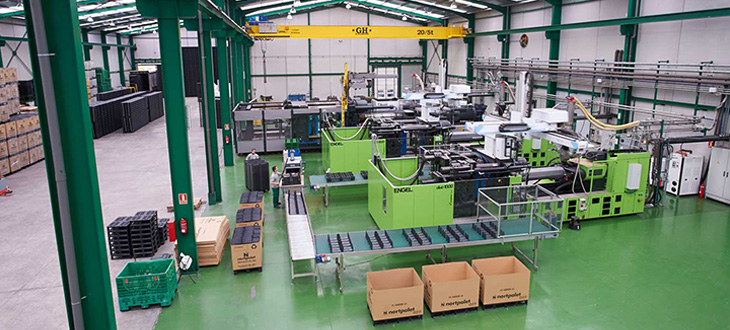The objective of the process is to optimize the pieces, that is, to improve their thickness and structure, reduce their weight, increase their durability and manufacture more and more sophisticated designs.
There are many techniques that exist today to manufacture plastic pallets, to the point that sometimes, it is difficult to choose the process that increases most the efficiency of the supply chain in our company. Among the most common manufacturing processes that we can find today are: injection, thermoforming, blowing, compression and roto-molding.
But in this post, we will focus on the plastic pallets manufacturing process by injection, because it is the technique that we use in Naeco considering that it is a system that, in addition to guaranteeing the quality of all our products, complies with the values that defines us most: sustainability and environmental care.
In the following lines, we explain how this process is developed, the different types of injection moulding that exist and their most outstanding advantages.
Phases of the plastic injection moulding technique
The manufacturing of plastic pallets by injection is one of the most used processes to give this material the wanted shape and size. It is the perfect technique when you want to carry out a large-scale production, especially when we need the same pallet design to be produced many times and to remain stable and equal over time.
In general, the injection process goes through the following manufacturing phases:
- The plastic is introduced into the machines through a hopper.
- The heating bands and the friction force melt the plastic material.
- The hot plastic, when in its liquid state, leaves the heating chamber through a nozzle towards a cavity or mold, where the pallet will take the shape of the mold mounted, after that it subsequently cools and hardens through a refrigeration system.
Types of injection systems
Within the process of plastic pallets manufacturing by injection, there are two types / production techniques that consist of: a low-pressure system and a high-pressure system. Do you want to know in what each of them is characterized and what are their advantages?
- Low pressure system: In this case, the mould cavity is injected with the plastic material and an inert gas. It’s to say, a gas that doesn’t react chemically with the material introduced. Carbon dioxide or nitrogen is usually used and when heating the mixture of nitrogen gas and polypropylene / polyethylene activates the blowing agents, which results in a cellular core surrounded by a rigid plastic material.
- Moulded by high pressure injection: The system of injection of high pressure is a process widely used in the manufacture of high-density polyethylene (HDPE) or polypropylene (PP) plastic pallets. It is a very precise process with a high gloss finish that does not require any subsequent treatment.
With this manufacturing technique, the raw material is heated inside a barrel that has a rotating screw at a temperature of around 250 degrees Celsius. Once the plastic reaches the wanted temperature, it is injected into a mold, where it is held under pressure, cooled and ejected at the end.
Therefore, the process of injection molding at high pressure is an ideal option when you need a plastic pallet with very intricate details.
Conclusion
Both the high-pressure injection and the low-pressure injection systems play a fundamental role in plastic pallets manufacturing.
Throughout the last years, the trend in the sector of plastic injection has evolved towards a machinery, quieter, less bulky, faster, with a lower environmental impact and a more contained hydraulic and energy consumption. For these and many other reasons Naeco has opted for this manufacturing process for their plastic pallets.














